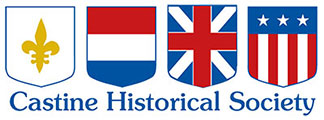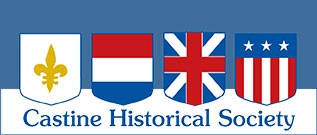View of the Port of Rochefort, where both Hermiones were constructed. Claude-Joseph Vernet, circa 1763.
History of Hermione
The First Hermione, and Lafayette- 1779-1780
The town of Rochefort, halfway down the Atlantic coast toward Spain had been building ships for the French Navy for more than a century. In 1778 she had been ordered to build a series of four identical 32-gun Frigates of new design: La Fee’, La Corageuse, La Concorde, and Hermione. Along with another group of four frigates to be built with somewhat similar design, they were noted for exceptional speed and maneuverability. Classed as light frigates, armed mostly with 12-pound cannon, they often took on the roles of our modern destroyers.
In May of 1779, this first Hermione had been launched, commissioned and was heading to sea on its first campaign less than a year after its keel had been laid. The captain of the Hermione was Louis Rene’ de LaTouche-Treville, native of Rochefort, who would remain at her helm until a year after the end of the war and become well regarded in his position.
The 6-month 1779 campaign in the Bay of Biscay and nearby ended well with the capture of a number of prizes. 1780 began with repairs and several upgrades to the ship, including the new technique of covering the ship’s bottom with copper sheathing, resulting in a speed increase of about 20%, making the Hermione one of the very fastest French Naval ships.
The Hermione-Lafayette Voyage to America, March 1780
The copper bottom was well suited for the next voyage, which was to safely transport the Marquis de Lafayette to America. Lafayette had just achieved the King’s approval for substantial military aid to be given to General Washington’s army. Needing to return to Washington with that secret message as quickly as possible, by the safest method, the Hermione was chosen for the task- and was ready. Quickly fitted-out for the comfort of the Marquis and his small entourage, the Hermione sailed for the USA on March 20th, 1780.
Sailing directly across the Atlantic instead of south to the Trade Winds route to avoid that crowded way, the Hermione made landfall in Massachusetts 38 days later on April 28th, 1780. Lafayette debarked safely in Boston and was soon riding south to Washington’s headquarters to deliver his secret message of French aid.
Thus the contribution of the Hermione to a watershed event in our Revolutionary War: the safe delivery of both Lafayette and his extraordinary message of French aid- that would transform the fighting ability of the Continental Army, bolster its forces with French troops and ships, and soon lead directly to the end of the war at Yorktown in October, 1781. The Hermione remained in America, battling the British Navy blockade and taking part in the French Naval force at Yorktown- spending nearly two years here before sailing back to France.
From that time, that first Hermione has been known in France as the Hermione-Lafayette, the Ship of Liberty; the Ship of the Enlightenment—with all the symbolism that brought to a lasting French pride in their contribution to the American experiment with independence—and liberty.
The New Hermione-Lafayette Project, 1997-2014
In 1997, the keel was laid in Rochefort for what has since become a precise replica of the original Hermione Frigate that carried Lafayette to our shores in 1780. The ship was finished in August 2014, and on sea trials off the French Atlantic coast. In the winter and spring of 2015, it prepared for its long-term objective: a voyage to America in 2015 to commemorate the voyage of the original Hermione that returned Lafayette to the USA, bringing his secret message of substantial French aid for Washington’s destitute army.
The story of how that keel came to be laid in 1997 began in the 1970s, when Rochefort decided to restore much of its former glory as a royal shipyard that dated from 1666. The goal was to attract tourists and historians to its somewhat remote coastal location. The old dry-docks, rope walk (the elegant corderie building) and gardens were restored. In 1993, a small group of aficionados proposed to replicate the Hermione, Lafayette’s ship of Liberty—and build it in the same Rochefort yards where the first Hermione was built in 1779. But there was an obstacle: the plans for the original Hermione had been lost. But France was now on good terms with England, and the complete plans of an identical sister ship, the Concorde, had been measured and drawn after she was captured by the English Navy in the 1790s. These plans were on file at the Admiralty, and easily obtained for the new Hermione project.
After 17 years in the building, in the autumn of 2014 the replica Hermione—the completed ship, rigged and armed with all its cannon, departed Rochefort for the Atlantic and its sea trials. Unlike its forbear, which took less than a year from keel to sea-going, the 17-year replica project had to progress no faster than mostly private funding would permit, with only a small number of volunteer shipwrights instead of the thousands that once swarmed the Rochefort yards and were paid from the King’s coffers. But the work was done with craft and respect, much of it employing a revival of 18th century talents and techniques, taking the time to be done very well.
The New Hermione-Lafayette: Coming to America, 2015
The pace of construction of the Hermione from 1997 was easily followed on the internet for many years. But it was not until the summer of 2012, when it was clear that the entire hull of the ship was finished and was being launched, that many far from Rochefort were suddenly made aware that the ship might soon sail on its original objective—the voyage to America, in commemoration of Lafayette’s famous crossing in 1780. Indeed, an initial route was published, with ten ports-of-call, from Yorktown to Boston, then at Halifax, Nova Scotia on the way home. At first 2014, then 2015 was posted to be the year of the voyage.
The ship was coming, and now it was America’s task to prepare for her. A new organization, The Friends of Hermione-Lafayette in America (FOH-LA ) was formed in New York, headed by Mr. Miles Young, CEO of Ogilvy&Mather, a world-wide advertising firm. It had the responsibility for both managing and gathering the funding and support for the entire voyage in American waters. Each of the selected ports-of-call were responsible for organizing their own welcome, and coordinating with the FOH-LA. With the publication of the route and the planned stops for the ship, a few people in Castine with knowledge of its history saw an opportunity, and the process of bringing her to Castine began.

